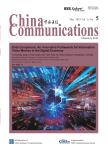Performance Analysis of Non-Identically Distributed FSO Systems with Dual- and Triple- Branch Based on MRC over Gamma-Gamma Fading Channels
Performance Analysis of Non-Identically Distributed FSO Systems with Dual-and Triple-Branch Based on MRC over Gamma-Gamma Fading Channels作者机构:State Key Laboratory of Integrated Service Networks School of Telecommunications Engineering Xidian University Xi'an 710071 China Xi'an Institute of Applied Optics Xi'an 71007 l China
出 版 物:《China Communications》 (中国通信(英文版))
年 卷 期:2018年第15卷第1期
页 面:45-51页
核心收录:
基 金:supported by the National Natural Science Foundation of China (Grant No. 61671347) the Fundamental ResearchFunds for the Central Universities (Grant No. 20106151859 & 20106161859) supported by 111 Project of China (B08038)
主 题:bit error rate dual-and triple-branch free-space optical systems Gamma-Gamma fading maximal ratio combining(MRC)
摘 要:In this work, the performance of free-space optical(FSO) communication system based on maximal ratio combining using binary phase shift keying subcarrier intensity modulation over Gamma-Gamma fading channels has been studied systematically. Under identically or non-identically distributed branches, the analytical expressions for the bit error rate function of signal-to-noise are derived by expressing the modified Bessel function of second kind with Meijer G-function for dualand triple-branch systems, respectively. In terms of H-fox function, the new expressions have more general forms and are more efficient for computation. It is found that the dual-and triple-branch systems significantly outperform the direct link system under weak, moderate and strong turbulence conditions. Monte Carlo simulation is also provided to confirm the accuracy of the proposed model.



